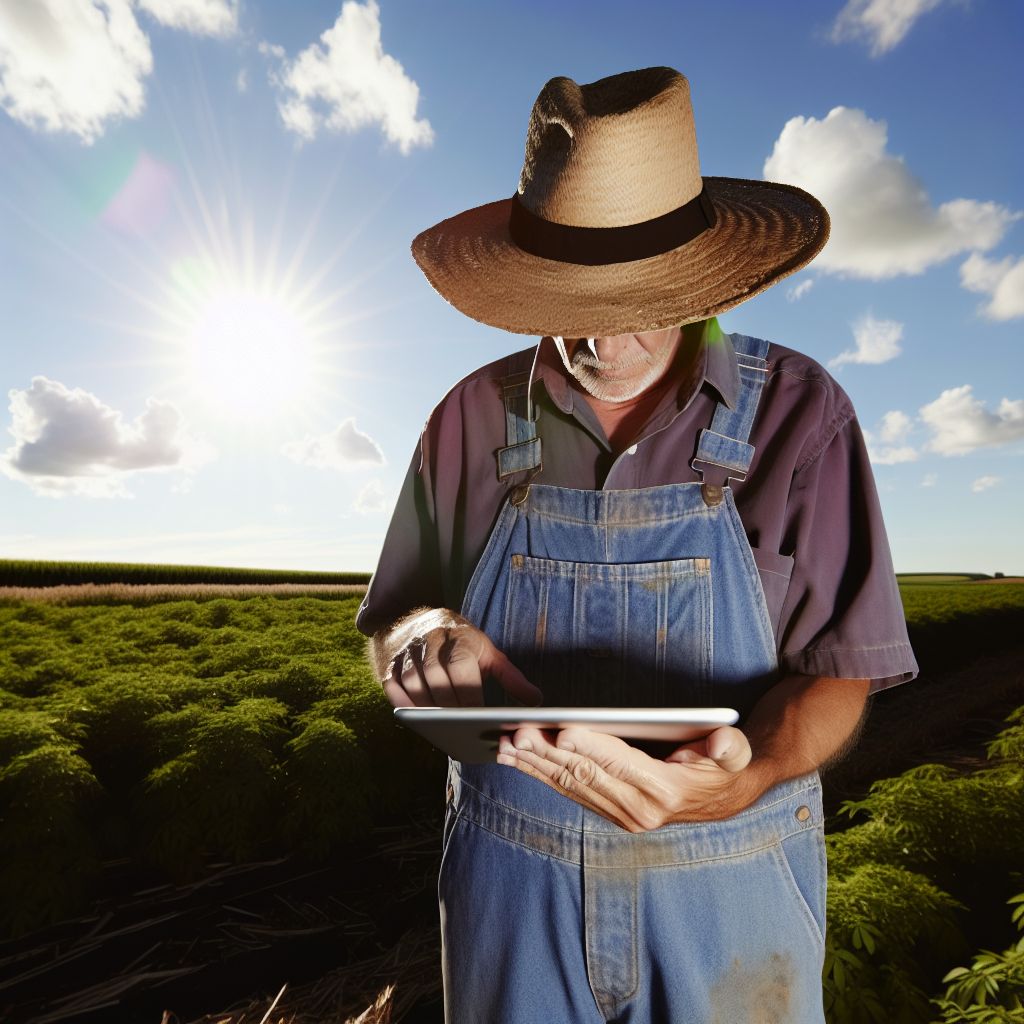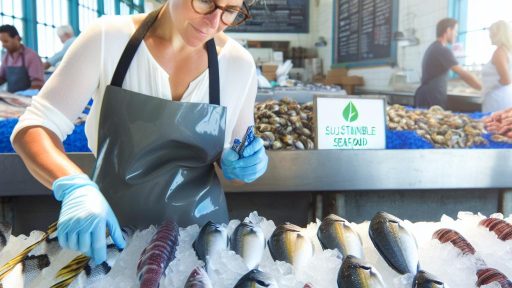Introduction to Food Traceability in Farming
Food traceability in farming plays a crucial role in modern agriculture.
It allows consumers to know the origins of their food products.
This transparency builds trust between consumers and producers.
Additionally, traceability enhances food safety measures.
Through traceability systems, farmers can track their produce more effectively.
Many consumers today demand high levels of transparency.
Consequently, traceability systems have become essential in agricultural practices.
Farmers track everything from seed planting to harvest using technology.
They document every step in the supply chain process.
This documentation can provide vital information about food quality.
Moreover, it helps in responding to food safety incidents.
For example, if a product is recalled, traceability systems identify affected batches.
Companies can also prove their sustainability practices through traceability.
Overall, food traceability fosters a more responsible agricultural sector.
This ultimately aligns with consumer expectations for safe, high-quality food.
Transform Your Agribusiness
Unlock your farm's potential with expert advice tailored to your needs. Get actionable steps that drive real results.
Get StartedHistorical Context of Food Traceability
Early Practices in Agriculture
In ancient civilizations, people relied on rudimentary methods to track food sources.
Farmers used local records to note crop yields and livestock movements.
This practice ensured that food was fresh and safe for consumption.
The Rise of Industrial Agriculture
The Industrial Revolution transformed farming practices dramatically.
As food production scaled up, traceability became more complex.
Large-scale operations needed better systems to monitor food safety.
Technological Advancements and Traceability
The 20th century introduced technologies that enhanced food traceability.
Barcoding systems emerged, allowing for improved tracking of products.
Thus, processors could quickly identify sources of contamination.
Legislation and Regulation
In response to food safety crises, regulations began to shape traceability practices.
Laws mandated record-keeping and transparency in the food supply chain.
Consumers demanded more information about their food sources.
Modern Systems of Traceability
Today, technology has revolutionized the way we trace food.
Blockchain technology provides secure and accessible tracking records.
Such systems enhance consumer trust and food safety.
The Impact of Globalization
Global trade has influenced food traceability significantly.
With international supply chains, monitoring food safety requires diligence.
Countries must cooperate to maintain standards and regulations.
Current Trends and Future Directions
Innovations continue to impact food traceability models today.
Consumers increasingly seek transparency in the food they purchase.
As a result, farms are adopting advanced technologies to meet these demands.
The Importance of Traceability in the Agricultural Supply Chain
Building Consumer Trust
Traceability empowers consumers with knowledge about their food sources.
Consumers increasingly demand transparency from food producers.
When they know where their food comes from, trust builds.
Showcase Your Farming Business
Publish your professional farming services profile on our blog for a one-time fee of $200 and reach a dedicated audience of farmers and agribusiness owners.
Publish Your ProfileReliable traceability ensures that producers maintain food safety.
Enhancing Food Safety
Traceability plays a vital role in identifying sources of contamination.
In cases of foodborne illness outbreaks, quick response is essential.
With clear traceability, recalling affected products becomes easier.
This minimizes health risks and protects consumers effectively.
Supporting Sustainable Practices
Traceability encourages environmentally friendly farming methods.
Consumers are more likely to support sustainable brands.
It helps farmers adopt practices that are beneficial for the ecosystem.
As a result, it promotes responsible consumption and production.
Facilitating Compliance and Regulation
Regulatory agencies require traceability to ensure food safety standards.
Farms must keep detailed records of their production processes.
This compliance can lead to better market access.
Farmers benefit from improved credibility within their industry.
Driving Market Differentiation
Traceable food products can be marketed as premium offerings.
Many consumers are willing to pay more for verified products.
Brands that provide traceability stand out in a competitive market.
This differentiation can lead to increased sales and loyalty.
Global Trade Considerations
International markets demand high standards of traceability.
Exporters must comply with various regulations across countries.
Traceability systems support cross-border trade in agricultural goods.
Producers can capture new opportunities in global markets.
Gain More Insights: Farm Fresh Delivery Services for Urban Communities
Technologies Used in Food Traceability
RFID Technology
Radio Frequency Identification (RFID) plays a vital role in food traceability.
This technology uses electromagnetic fields to automatically identify and track tags attached to objects.
RFID tags store crucial information about products throughout the supply chain.
Farmers can easily monitor individual items from harvest to distribution.
Moreover, RFID technology enhances inventory management and reduces waste.
As a result, it improves overall efficiency in farming operations.
QR Codes
Quick Response (QR) codes provide an accessible way for consumers to trace food products.
These codes can be scanned using smartphones for instant access to product information.
They reveal the journey of food items, including origin and processing details.
Furthermore, QR codes connect consumers directly with producers, fostering trust.
In addition, they are cost-effective and easy to implement across various products.
Overall, QR codes enhance transparency within the food industry.
Blockchain Technology
Blockchain technology offers a decentralized approach to food traceability.
This system allows for secure and transparent record-keeping throughout the supply chain.
Each transaction is immutable, ensuring that data cannot be altered or deleted.
This increases accountability among producers, distributors, and retailers.
Furthermore, blockchain provides a reliable source of truth for all stakeholders.
As a result, it significantly boosts consumer confidence in food safety and quality.
Showcase Your Farming Business
Publish your professional farming services profile on our blog for a one-time fee of $200 and reach a dedicated audience of farmers and agribusiness owners.
Publish Your ProfileSee Related Content: Artisanal Food Production for Wildcrafted and Foraged Ingredients
Case Studies of Successful Traceability Systems in Farming
Woolworths’ Farm to Fork Initiative
Woolworths implemented a Farm to Fork initiative to enhance food traceability.
This program provides detailed origin information for products.
Farmers must register their produce to participate.
Consumers can access data about the producer via a QR code.
This transparency builds consumer trust and confidence in food safety.
IBM Food Trust and Walmart
IBM Food Trust partnered with Walmart to improve supply chain transparency.
This blockchain-based system allows tracing of food products in seconds.
Walmart uses this technology to track leafy greens specifically.
In case of contamination, rapid response measures can be activated.
As a result, customers feel more secure about their purchases.
Oregon’s Seed to Supper Program
The Seed to Supper program educates new gardeners in Oregon.
Participants learn about vegetable gardening and food sustainability.
Traceability is highlighted in the program by connecting seeds to local farms.
Community members gain insights into where their food comes from.
This initiative cultivates trust among consumers and promotes local agriculture.
Tyson Foods’ Traceability System
Tyson Foods developed an advanced traceability system for livestock.
They utilize unique identification tags for individual animals.
This method allows for tracking from farm to processing plant.
Consumer safety is enhanced by quick recalls if necessary.
The system has increased transparency and has reassured consumers.
Gain More Insights: Farm-To-Table Events for Supporting Farm Cooperatives and Rural Growth
Impact of Food Traceability on Consumer Trust and Safety
Enhancing Transparency in the Supply Chain
Food traceability increases transparency within the agricultural supply chain.
This transparency allows consumers to track the origin of their food.
As a result, consumers feel more secure about the food they purchase.
Moreover, traceability systems empower consumers to make informed choices.
Building Consumer Confidence
When consumers know the journey of their food, they build trust.
Traceability assures them of safety and quality standards.
For instance, suppliers like Green Farms emphasize their traceability system.
This commitment improves their overall reputation among buyers.
Addressing Food Safety Incidents
In case of a food safety issue, traceability becomes critical.
It allows for swift identification and recall of affected products.
Companies can limit health risks by acting quickly.
Many brands, such as Fresh Organics, utilize this system for consumer safety.
Promoting Sustainable Practices
Traceability supports sustainable farming practices as well.
Consumers increasingly prefer sustainably sourced products.
This shift reduces environmental impact while ensuring food quality.
Consequently, traceability can enhance brand loyalty and customer retention.
Increasing Regulatory Compliance
Food traceability helps businesses comply with relevant regulations.
Governments require traceability systems for food safety management.
Showcase Your Farming Business
Publish your professional farming services profile on our blog for a one-time fee of $200 and reach a dedicated audience of farmers and agribusiness owners.
Publish Your ProfileFor instance, the European Union mandates this for all food producers.
As compliance increases, consumer trust also grows.
Creating Educational Opportunities
Traceability systems provide educational benefits for consumers.
Consumers learn about food sourcing and production methods.
This knowledge further boosts confidence in food choices.
Organizations often hold workshops to train consumers on tracing methods.
Explore Further: Permaculture Practices for Enhancing Biodiversity on Farmlands

Challenges and Barriers to Implementing Traceability in Farming
Technological Limitations
The adoption of traceability systems requires advanced technology.
Many farms lack access to the necessary tools and software.
This issue can hinder efficient data collection and sharing.
Additionally, outdated equipment often complicates integration.
Farms, especially smaller ones, may struggle to afford upgrades.
Cost Implications
Implementing a traceability system incurs significant costs.
Farms must invest in technology, staff training, and maintenance.
For many, these initial expenses can be prohibitive.
Ongoing costs for system updates can also add financial strain.
Regulatory Challenges
The complexity of food safety regulations varies by region.
Farmers must understand and comply with numerous guidelines.
This task can be overwhelming and resource-intensive.
Moreover, inconsistent regulations across borders create confusion.
Consumer Awareness and Demand
Many consumers lack awareness of traceability benefits.
This limited understanding diminishes demand for traceable products.
Farms often hesitate to invest without assured consumer interest.
Educating consumers is vital for driving this demand.
Cultural and Social Factors
In some regions, traditional farming practices prevail.
Farmers may resist adopting new technologies or systems.
This cultural inertia presents a barrier to modernization.
Engagement with communities can facilitate smoother transitions.
Data Privacy Concerns
Farmers worry about the privacy of their business data.
Sharing information can expose them to competitive risks.
Developing secure systems is essential for building trust.
Transparency must be balanced with appropriate privacy measures.
Regulatory Frameworks and Standards Governing Food Traceability
Importance of Food Traceability
Food traceability enhances safety within the food supply chain.
It enables quick response and recalls in the event of contamination.
Moreover, it promotes transparency, allowing consumers to make informed choices.
International Standards for Traceability
Several international standards define guidelines for food traceability.
The Codex Alimentarius provides critical recommendations for food safety.
Additionally, ISO 22005 outlines requirements for tracing food products.
These standards ensure consistency across different countries and markets.
Regulations in the United States
The FDA Food Safety Modernization Act emphasizes safety throughout the supply chain.
Showcase Your Farming Business
Publish your professional farming services profile on our blog for a one-time fee of $200 and reach a dedicated audience of farmers and agribusiness owners.
Publish Your ProfileThis act mandates comprehensive traceability for certain high-risk foods.
Furthermore, the U.S. Department of Agriculture implements traceability requirements for meat and poultry.
European Union Regulations
The EU has established strict regulations for food traceability.
Regulation (EC) No 178/2002 outlines general principles and requirements for food law.
It necessitates that all food must be traceable at all stages of production.
Technological Support for Traceability
Technology plays a vital role in improving traceability in farming.
Blockchain technology provides a decentralized and tamper-proof record.
Moreover, RFID tags and QR codes allow easy access to product information.
Industry Standards and Certification
Several industry standards support food traceability initiatives.
GlobalGAP certification ensures good agricultural practices and traceability.
Additionally, HARPC principles focus on hazard analysis and risk-based preventive controls.
Challenges in Implementation
Implementing traceability standards can present challenges for some producers.
Small farmers often struggle with the cost of compliance and technology.
Furthermore, inconsistent regulations across regions can complicate efforts.
Future Directions
The future of food traceability is likely to involve more robust regulations.
Increasing consumer demand for transparency will drive innovation.
Ultimately, a unified approach to traceability can enhance consumer trust.
The Role of Consumer Education in Enhancing Traceability Systems
Understanding Food Traceability
Food traceability refers to tracking food products throughout the supply chain.
It allows consumers to know the origin of their food.
Additionally, it helps ensure food safety and quality.
Building Consumer Trust
Consumer trust is essential in today’s food market.
Transparent traceability systems can enhance this trust.
Farming practices should prioritize traceability to boost consumer confidence.
The Importance of Consumer Education
Educating consumers on traceability fosters informed choices.
Consumers need to understand how traceability works.
They should know the benefits of supporting traceable food sources.
Strategies for Effective Education
- Conduct workshops to explain traceability processes.
- Create informative pamphlets about the food supply chain.
- Use social media to share stories about food origins.
Engaging with Consumers
Engagement is crucial for successful education programs.
Use interactive platforms to facilitate discussions on traceability.
Invite consumers to farm visits to see traceability in action.
Measuring Impact
Organizations should evaluate the effectiveness of education initiatives.
Feedback from consumers can provide valuable insights.
Analyzing purchasing patterns helps assess changes in consumer behavior.
Additional Resources
Blockchain in the food supply chain – What does the future look like?




